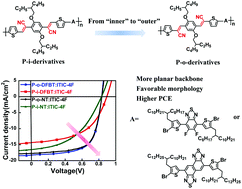Influence of the –CN substitution position on the performance of dicyanodistyrylbenzene-based polymer solar cells†
Abstract
Molecular engineering of polymer donors is imperative to improve the photovoltaic performance of polymer solar cells (PSCs). Here, we report that the substitution position of the –CN group in dicyanodistyrylbenzene (DCB) moiety-based copolymers greatly affected the molecular packing and photovoltaic performance of PSCs. Four novel copolymers based on DCB units as electron donors and 5,6-difluorobenzo[c][1,2,5]thiadiazole (DFBT) or naphtho[1,2-c:5,6-c′]bis[1,2,5]thiadiazole (NT) units as electron acceptors were designed and synthesized to investigate the effects of altering the –CN substitution position. Density functional theory (DFT) calculations showed that the P-o-derivative copolymers, i.e., those with outer substitution positions, possessed a more planar conjugated backbone than the P-i-derivative copolymers, i.e., those with inner substitution positions, which enhanced the absorption coefficient and provided higher charge mobility. Moreover, two-dimensional (2D) grazing incidence wide-angle X-ray scattering (GIWAXS) patterns showed clearly that the P-o-derivative blends exhibited strong face-on π–π stacking. This ordered polymer packing facilitated charge transport in the vertical direction. In contrast, the P-i-derivative blends were prone to edge-on lamellar stacking. Combining each copolymer with a small molecular acceptor (ITIC-4F), an optimum power conversion efficiency (PCE) of 10% was achieved for the P-o-derivative blend devices, whereas the devices based on the P-i-derivative copolymers exhibited a PCE of only 6.67%. Our comparative research indicates that changing the functional group substitution position could affect molecular packing and molecular properties. This approach provides a path toward the molecular design of more materials for high-performance PSCs.



 Please wait while we load your content...
Please wait while we load your content...